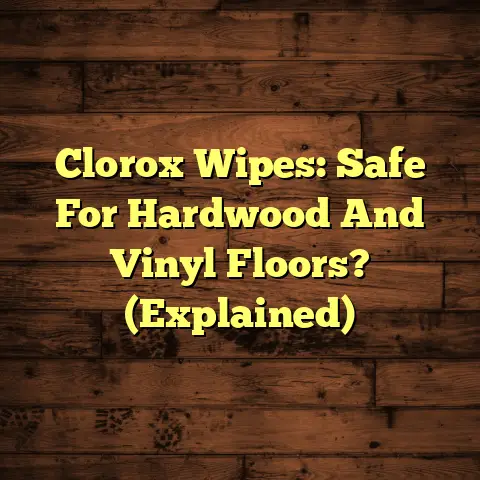Clean Greasy Restaurant Floors? (1-Step Fix!)
The restaurant industry is a whirlwind of innovation, isn’t it? From those fancy automated kitchens to the tablets on every table, tech’s changing everything. But amidst all the buzz, one old problem sticks around: greasy floors.
They’re a pain, a safety hazard, and a magnet for bad reviews. But what if I told you there’s a game-changing, one-step fix? Stick with me, and I’ll spill the beans!
Section 1: The Challenge of Greasy Restaurant Floors
Understanding the Problem
So, what exactly makes restaurant floors so greasy?
It’s a perfect storm of factors. We’re talking about food spills, oil splatters from the grill, and constant foot traffic grinding everything in.
Think about it: a busy kitchen is basically a grease explosion waiting to happen. That grease gets tracked everywhere.
And it’s not just the kitchen. Dining areas suffer too, with dropped food and spilled drinks adding to the mess.
But beyond the ick factor, greasy floors are a real problem.
First off, customer perception. A greasy floor screams “dirty,” even if the rest of the place is spotless.
No one wants to eat in a place that feels unclean.
Then there’s safety. Greasy floors are slip-and-fall accidents waiting to happen.
According to the CDC, over one million Americans suffer slip, trip, and fall injuries each year.
Restaurants are prime territory for these accidents. And trust me, a lawsuit is the last thing you want.
And finally, there are health regulations. Health inspectors don’t mess around.
Greasy floors can lead to violations, fines, or even temporary closures. Nobody wants that!
The Importance of Flooring Maintenance
Clean floors are the foundation of a clean restaurant. It’s that simple.
When floors are clean, it sets the tone for the entire establishment. Customers feel more comfortable, and staff are more motivated.
Neglecting floor cleanliness can have serious consequences. I already mentioned health code violations and accidents.
But there’s also the long-term damage to your floors. Grease can seep into porous surfaces, causing stains and odors that are impossible to remove.
Replacing floors is expensive. Proper maintenance is a much smarter investment.
Plus, a clean restaurant is just good business. It attracts more customers, boosts morale, and keeps the health inspectors happy.
Section 2: Traditional Cleaning Methods
Overview of Conventional Approaches
Let’s talk about the old-school ways of cleaning greasy floors.
The most common method is mopping with soap solutions. It’s cheap and easy, but it’s also time-consuming and often ineffective.
You’re basically pushing the grease around, not really removing it.
Chemical cleaners are another option. They can be more effective than soap, but they also come with drawbacks.
Many chemical cleaners are harsh and can damage certain types of flooring. Plus, they can be harmful to the environment.
Steam cleaning is another popular method. It uses high-pressure steam to lift grease and dirt from the floor.
It’s effective, but it requires specialized equipment and can be quite labor-intensive.
Limitations of Traditional Solutions
The problem with these traditional methods is that they all have limitations.
Mopping is slow and often leaves behind a greasy residue. Chemical cleaners can be harsh and environmentally unfriendly.
Steam cleaning is expensive and time-consuming.
And all of these methods require significant downtime. You have to close off sections of the restaurant while the floors are being cleaned.
That means lost revenue.
Another issue is the recurring greasy buildup. Traditional methods often fail to completely remove the grease, leading to a gradual buildup over time.
This means you have to clean more frequently, which adds to the labor costs.
And let’s not forget about the environmental impact. Many traditional cleaning solutions contain harsh chemicals that pollute waterways and harm ecosystems.
Section 3: The Tech Revolution in Floor Cleaning
Tech Innovations Transforming Cleaning
The good news is that technology is changing the game when it comes to floor cleaning.
We’re seeing some amazing innovations that are making it easier and more efficient to keep restaurant floors clean.
Automated scrubbers are one example. These machines can scrub and clean large areas of flooring with minimal human intervention.
They’re perfect for large restaurants with extensive floor space.
Eco-friendly cleaning agents are another exciting development. These cleaners are made from natural, biodegradable ingredients and are just as effective as traditional chemical cleaners.
They’re a great way to reduce your environmental impact without sacrificing cleanliness.
And then there are innovative floor coatings. These coatings create a protective barrier on the floor, making it easier to clean and preventing grease from seeping into the surface.
Case Studies: Successful Implementation
I’ve seen firsthand how these technologies can transform restaurant cleaning.
I worked with a local diner that was struggling with greasy floors. They were using traditional mopping methods, but they just couldn’t keep up with the grease buildup.
I recommended they try an automated scrubber with an eco-friendly cleaning agent. The results were amazing.
The scrubber cleaned the floors much faster and more effectively than the old mopping method. And the eco-friendly cleaner left the floors sparkling clean without any harsh chemicals.
The restaurant owner told me that he was saving hours of labor each week and that his customers were noticing the difference.
I also worked with a high-end restaurant that installed a new floor coating. The coating made the floors much easier to clean, and it prevented grease from staining the surface.
The restaurant manager told me that the coating had significantly reduced their cleaning costs and improved the overall appearance of the restaurant.
These are just a couple of examples of how technology can revolutionize restaurant cleaning.
Section 4: The 1-Step Fix for Greasy Floors
Introducing the 1-Step Fix
Alright, let’s get to the good stuff.
What’s this one-step fix I’ve been teasing?
It’s a specific type of enzymatic floor cleaner combined with a microfiber mopping system.
Enzymatic cleaners use natural enzymes to break down grease and organic matter.
Microfiber mops are far more effective at picking up dirt and grease than traditional cotton mops.
The magic is in the combination.
The enzymes break down the grease, and the microfiber mop lifts it away, leaving the floor clean and residue-free.
What sets this apart? It’s the simplicity and the effectiveness.
No rinsing, no harsh chemicals, just clean floors.
Step-by-Step Application
Here’s how to use this one-step fix:
-
Preparation: Clear the area of any obstacles. Sweep or vacuum the floor to remove loose dirt and debris.
-
Mixing: Dilute the enzymatic cleaner according to the manufacturer’s instructions. Typically, it’s a few ounces per gallon of water.
-
Application: Dip the microfiber mop into the cleaning solution. Wring out the excess liquid. You want the mop to be damp, not soaking wet.
-
Mopping: Mop the floor in overlapping strokes. Pay special attention to areas with heavy grease buildup.
-
Drying: Allow the floor to air dry. In most cases, the floor will dry within minutes.
-
Post-Cleaning Maintenance: Rinse the microfiber mop after each use. Launder the mop heads regularly to prevent buildup.
For heavily soiled areas, you may need to pre-treat with a concentrated solution of the enzymatic cleaner.
Simply spray the solution on the affected area and let it sit for a few minutes before mopping.
Section 5: Benefits of the 1-Step Fix
Efficiency and Time Savings
The biggest benefit of this one-step fix is the time savings.
Traditional mopping methods can take hours, especially in large restaurants.
With this system, you can clean the same area in a fraction of the time.
I’ve seen restaurants cut their floor cleaning time in half by switching to this method.
That’s a huge savings in labor costs.
Plus, the quick drying time means you can get back to business faster. No more waiting around for hours for the floors to dry.
That means less downtime and more revenue.
Enhanced Safety and Hygiene
Clean floors are safer floors. It’s that simple.
By removing the grease and grime, you’re reducing the risk of slip-and-fall accidents.
This is especially important in high-traffic areas like kitchens and dining rooms.
According to the National Floor Safety Institute, slips and falls account for over one million hospital emergency room visits each year.
Maintaining clean floors is a crucial step in preventing these accidents.
And of course, clean floors are more hygienic.
By removing the grease and organic matter, you’re reducing the risk of bacteria growth.
This is essential for maintaining a healthy environment for your customers and staff.
A clean restaurant is a happy restaurant.
Cost-Effectiveness
Let’s talk about the bottom line. Is this one-step fix cost-effective?
Absolutely.
While the initial investment in an enzymatic cleaner and microfiber mops may be slightly higher than traditional cleaning supplies, the long-term savings are significant.
You’ll save money on labor costs, as the cleaning process is much faster and more efficient.
You’ll also save money on cleaning supplies, as enzymatic cleaners are typically more concentrated and last longer than traditional chemical cleaners.
And you’ll save money on floor repairs, as the enzymatic cleaner helps to prevent grease from damaging the flooring.
Over time, the savings will far outweigh the initial investment.
Plus, consider the cost of a slip-and-fall accident or a health code violation.
Investing in a good floor cleaning system is a smart way to protect your business from these potential liabilities.
Section 6: Conclusion
Reinforcing the Importance of Clean Floors
Clean floors are not just a cosmetic issue. They’re a critical component of restaurant success.
They impact customer satisfaction, employee morale, and regulatory compliance.
By adopting the one-step fix, you can transform your restaurant’s cleanliness and create a safer, healthier environment for everyone.
It’s a game-changer for restaurant cleanliness.
The Future of Restaurant Cleaning
The restaurant industry is constantly evolving. And so are cleaning technologies.
We’re seeing new innovations all the time, from self-cleaning floors to AI-powered cleaning robots.
The future of restaurant cleaning is bright.
I encourage restaurant owners to embrace these innovations and to invest in the best possible cleaning solutions.
Not only will it enhance your operations, but it will also ensure the health and safety of your patrons.
So, ditch the old mop and bucket and embrace the future of clean. Your floors (and your customers) will thank you for it.
And that’s all for today, folks! I hope this article has been helpful.
Remember, a clean restaurant is a successful restaurant. Now go out there and make those floors shine!





